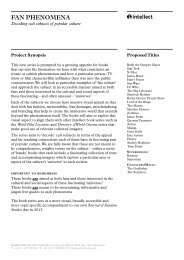Anthem - Intellect
Anthem - Intellect
Anthem - Intellect
You also want an ePaper? Increase the reach of your titles
YUMPU automatically turns print PDFs into web optimized ePapers that Google loves.
<strong>Anthem</strong><br />
on top. The last variation is extended in an exalted frenzy, which suddenly quiets<br />
down around six minutes into the movement.<br />
B. Bar 208–330. The sounds from the d-minor introduction reappear for a<br />
minute, again with chaotic drums being interrupted by the same recitative as before,<br />
this time sung by a baritone on lyrics by Beethoven: ‘O Freunde, nicht diese Töne! /<br />
sondern lasst uns angenehmere anstimmen, / und freudenvollere. / Freude! Freude!’<br />
(‘Oh friends, not these tones! / Rather, let us raise our voices in more pleasing / and<br />
more joyful sounds! / Joy! Joy!’). 374 At bar 241, this opens up the D-major vocal ‘Joy’<br />
variations 4–6, with the Schiller lyrics of verses 1–3, starting with ‘Freude, schöner<br />
Götterfunken, / Tochter aus Elysium, / wir betreten feuertrunken, / Himmlische, dein<br />
Heiligtum!’ (‘Joy, beautiful spark of divinity / daughter of Elysium, / We enter, drunk<br />
with fire, / into your sanctuary, heavenly (daughter)!’). The first time, a solo voice is<br />
accompanied by the choir in the last eight bars of the tune, like a chorus. Each of these<br />
variations adds voices, creating a climactic process. The second repetition involves a<br />
polyphonic solo song ensemble and a chorus in full choir like before; the third varies<br />
the melody so that it almost sounds like laughter. It ends with a transitory extension.<br />
The introduction to the movement thus presents three different musical ideas<br />
that each time ends in chaos (A). They echo each of the preceding three movements,<br />
so that the finale starts by summing up what has come before, but it is also easy to<br />
interpret them as symbolising three failed efforts to live together or build a society.<br />
This interpretation is particularly invited by the words ‘Oh friends, not these tones!’,<br />
and not least by the following ‘Ode to Joy’ lyrics that immediately forces the listener to<br />
hear this melody as the only successful way out of the compositional impasse—as well<br />
as of the interactional impasse for humanity which it has signified (B). At this point,<br />
the ‘Ode’ tune has the role of a jubilant and in many ways is a simple solution after so<br />
many efforts to integrate deeply divided forces: a strong and accessible hymn which<br />
lifts the whole symphony to a new—higher and more solemn but also more basic and<br />
popular—level.<br />
In Greek mythology, the virtuous heroes had the privilege to rest in the Elysian<br />
fields of the Underworld. 375 Schiller’s ‘Ode to Joy’ constructed joy as a ‘beautiful spark<br />
of divinity’ and ‘daughter of Elysium’, that is happiness as a personification of a divine<br />
spark to humanity from the paradise of eternal rest. This is already a quite complex<br />
picture. On the one hand, this joy is described as an elevating energy from the gods,<br />
parallel to how Prometheus stole fire to humanity. This is reinforced by the next line<br />
that depicts how ‘we enter, drunk with fire’ into the holy place or ‘sanctuary’ of joy. On<br />
the other hand, the dimension of eternity also makes death and the dead present in<br />
this joy, and the fire-drunkenness is also not without its dangers: this joy is obviously<br />
sublime rather than just pleasantly relaxed. The joy could remind of the intense<br />
desire in Europa and the bull, but surviving fire may also recall the resurrection of<br />
the Phoenix. The cathartic release is further emphasised by the next lines that talk<br />
165












